As a gardener I wonder how many fellow gardeners are watching the CNN Special Planet In Peril, http://www.cnn.com/SPECIALS/2007/planet.in.peril/.
Most gardeners, especially those that like to push climate zones can without question state that there are climate changes going on.
For example, here in
Indiana, which has been moved from a zone 5 to a zone 6, I am growing Livingstonia chinensis in the ground all year. I do put a small cold frame over it in the winter which I then stuff with pine needles and leaves. But, even with those protective measures, this plant should not survive the winter here.
The next issue they are looking at is vanishing habitats. I really think this area goes hand in hand with disappearing species and population growth, which are all areas they will be exploring.
One way gardeners can help is to take a section of your yard and let it grow wild. Planting native trees, flowers and grasses can help give wildlife a safe place to hide. Many of these plants also provide food for wild species. If your goal is to attract wildlife to your yard, then be sure to have places where they can get fresh water. A birdbath, a pond or even a shallow bowl will work.
You can even go a step further and become a certified backyard wildlife habitat like we did this spring. For more information go to http://www.nwf.org/backyard/70000goal.cfm
As the population continues to grow and more houses are built it is extremely important that we do not crowd out the native plants and animals. They belong here as well. We need to do what we can to preserve their native habitats and provide the ones that are displaced with new areas that provide shelter, food and water.
If we don’t take action now, what will be left for future generations?
For additional tips on going green visit http://www.cnn.com/2007/TECH/science/10/19/pip.greentips/index.html



